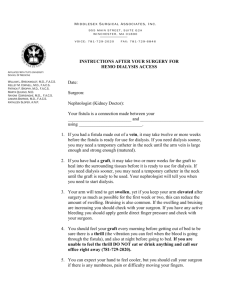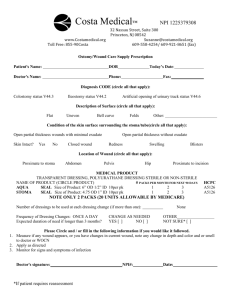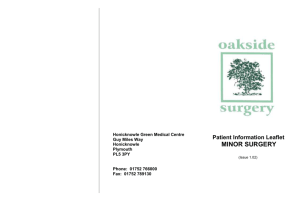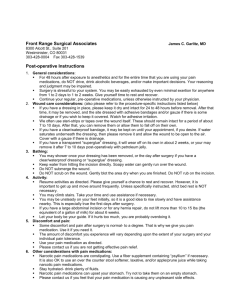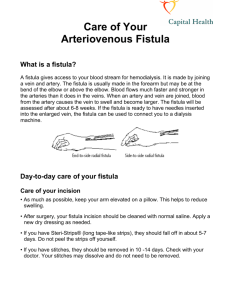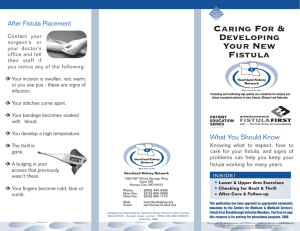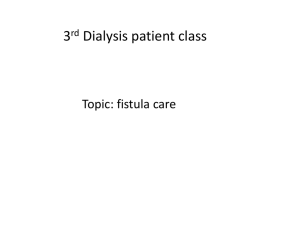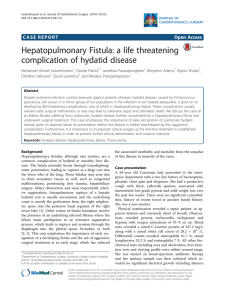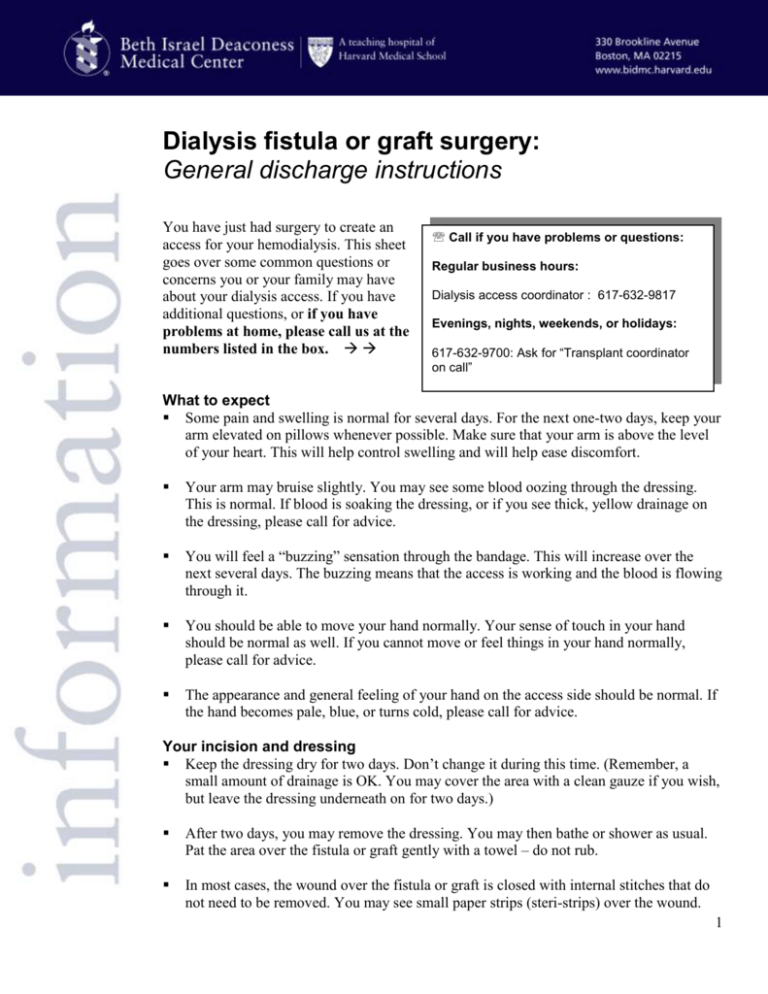
Dialysis fistula or graft surgery:
General discharge instructions
You have just had surgery to create an
access for your hemodialysis. This sheet
goes over some common questions or
concerns you or your family may have
about your dialysis access. If you have
additional questions, or if you have
problems at home, please call us at the
numbers listed in the box.
Call if you have problems or questions:
Regular business hours:
Dialysis access coordinator : 617-632-9817
Evenings, nights, weekends, or holidays:
617-632-9700: Ask for “Transplant coordinator
on call”
What to expect
Some pain and swelling is normal for several days. For the next one-two days, keep your
arm elevated on pillows whenever possible. Make sure that your arm is above the level
of your heart. This will help control swelling and will help ease discomfort.
Your arm may bruise slightly. You may see some blood oozing through the dressing.
This is normal. If blood is soaking the dressing, or if you see thick, yellow drainage on
the dressing, please call for advice.
You will feel a “buzzing” sensation through the bandage. This will increase over the
next several days. The buzzing means that the access is working and the blood is flowing
through it.
You should be able to move your hand normally. Your sense of touch in your hand
should be normal as well. If you cannot move or feel things in your hand normally,
please call for advice.
The appearance and general feeling of your hand on the access side should be normal. If
the hand becomes pale, blue, or turns cold, please call for advice.
Your incision and dressing
Keep the dressing dry for two days. Don’t change it during this time. (Remember, a
small amount of drainage is OK. You may cover the area with a clean gauze if you wish,
but leave the dressing underneath on for two days.)
After two days, you may remove the dressing. You may then bathe or shower as usual.
Pat the area over the fistula or graft gently with a towel – do not rub.
In most cases, the wound over the fistula or graft is closed with internal stitches that do
not need to be removed. You may see small paper strips (steri-strips) over the wound.
1
These fall off on their own in about seven to ten days. (If they fall off sooner, it is okay
as long as the wound is not opening.)
Some redness right around the incision is normal. However, if there is redness or warmth
that is increasing or spreading, please call us for advice.
Call for advice if you notice thick drainage coming from the wound, or if the edges of
the wound start to separate.
Medications
You will be discharged with a prescription for pain medication. Please take as directed.
The medicine should ease the discomfort at the site, although you will continue to feel
some discomfort over the next few days. If pain at the site is severe, or if it does not get
better with medicine, please call for advice.
The pain medicine may cause constipation. Talk with your own doctor about whether
you need to take a stool softener or mild laxative.
We recommend that you do not take prescription pain medication for longer than three
days. If you feel you need medicine for longer than three days, please call for advice.
You should go back to taking the medicines you were on before surgery, unless you
have been told differently by your doctor. Please note: if you were taking blood-thinning
medicine before surgery (such as aspirin, warfarin [Coumadin], ibuprofen, Aleve, Ticlid,
Aggrenox, Plavix, Lovenox, heparin, Pradaxa [dabigatran], rivaroxaban [Xarelto]),
please talk with your doctor about when to resume this medicine. If your doctor wants
you to change or stop taking your blood-thinning medicine (even for a short period),
someone must contact the doctor who prescribed the medicine to make sure this change
is safe for you.
Activity
Avoid lifting anything weighing more than ten pounds for the next three days. Ten
pounds is about the weight of two phone books or a gallon of milk. Lifting may put a
strain on the incision before it has had a time to heal.
Please avoid heavy physical exercise or exertion for two weeks.
You may drive when you are no longer taking prescription pain medicine.
You may go back to routine daily activities as soon as you like (as long as they don’t
involve heavy lifting).
If you have a fistula, please begin fistula exercises one week after surgery. Fistula
exercises will help your fistula enlarge and mature. To perform fistula exercises:
2
Get a tennis ball, nerf-ball, or other soft ball that you can hold comfortably in
your hand.
Place the ball in the hand on the same side as your fistula.
Squeeze the ball 10 to 15 times a minute for one-two minutes.
Repeat the exercise 10 to 20 times a day.
Some don’ts
Your access will need some long-term attention to make sure it continues to function well.
Please note the following precautions, which you must follow for as long as you have this
access:
Don’t let anyone draw blood or put an IV in your access arm. (Ask your doctor or nurse
about how to order a bracelet that will alert health care providers that you have a dialysis
access.)
You should not have your blood pressures taken in your access arm.
Don’t wear a tight sleeve, a watch, or other constricting jewelry on your access arm.
Don’t carry a handbag or briefcase on your access arm.
Try not to sleep on your access arm.
Call for advice if…
Please call us at the numbers listed on the front of this brochure if you notice any of the
following:
severe numbness, tingling, or pain in your access hand
you are unable to move your access hand
swelling, pain, and redness that gets worse instead of better
a lot of blood soaking through your dressing
thick drainage (pus) coming from your wound
chills, or a fever more than 100 F
your hand becomes very cold, pale or a bluish color
you do not feel the buzzing sensation in your access
Over
3
Follow-up appointment
You should make an appointment to see the surgeon who placed your access in about two
weeks. Please call: 617-632-9700 to schedule this appointment.
Appointment date and time (about 2 weeks after surgery):___________________________
This material was prepared by clinicians from the transplant department at Beth Israel Deaconess Medical Center. It is produced and
distributed by The Beth Israel Deaconess Learning Center. ©2011, Beth Israel Deaconess Medical Center. All rights reserved.
MC0904 05/11
4



